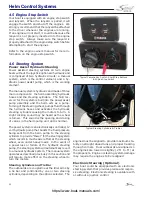
48
Helm Control Systems
• Trolling feature that allows the operator
to increase the engine speed in 50 RPM
increments while operating at trolling speeds
between 600 - 1000 RPM.
• Station transfer that allows the operator to
transfer control from one station to another
with the push of a button on boats with two
helm stations. Each station must be selected
before the controls will operate from that
station.
These features and others not mentioned require
specific procedures to activate and operate them
properly. Some of the procedures and features
are unique to the engines and other options
installed on your boat. It is essential that you
read the owner’s manual for the controls and be
completely familiar with their operation before
using your boat.
CAUTION
ALWAYS RETURN THE ENGINE THROTTLE LEVER TO THE
EXTREME LOW SPEED POSITION BEFORE SHIFTING. NEVER
SHIFT THE UNIT WHILE ENGINE SPEED IS ABOVE IDLE RPM.
Engine Synchronizer
During most operations of a twin engine boat, it is
advantageous for both engines to be operated at
the same RPM. This reduces noise and vibration
and can increase engine efficiency. Setting the
throttles so that the engines are running the same
RPM (synchronized) can be done by listening to
the engine sounds at low RPM and with the auto-
matic synchronizer feature built into the electronic
engine controls when the engines are operating
above 1000 RPM. Attempting to synchronize the
engines solely by using the tachometer readings
or control lever placement generally will not work.
When the engines are in proper synchronization,
the throttle levers may not necessarily be even.
Please refer to the engine or control owner’s
manuals for more information on the engine
synchronizer and other features for the electronic
controls installed on your boat.
4.3 Neutral Safety Switch
Every control system has a neutral safety switch
incorporated into it. This device prohibits an en-
gine from being started while the shift lever is in
any position other than the neutral position. If
the engine will not start, slight movement of the
shift lever may be necessary to locate the neutral
position and disengage the safety cutout switch.
Control adjustments may be required to correct
this condition should it persist. See your Scout
dealer for necessary control adjustments.
The neutral safety switches should be tested peri-
odically to ensure that they are operating properly.
To test the neutral safety switches, make sure the
engines are tilted down and move the shift levers
to the forward position.
Make sure the throttle control levers are not
advanced past the idle position. Press the
Start Button or turn the key just long enough to
briefly engage the starter for the engine.
Notice:
Some outboard control systems are equipped
with a computer controlled start feature that
will keep the starter engaged until the engine
starts if the neutral safety switch fails and
allows the starter to engage.
The starter should not engage for any engine.
Repeat this test with the shift levers in reverse
and the engine throttles at idle. Again, the starter
should not engage for any engine. If the starter
for any engine engages with the shift controls in
any position other than the neutral position, then
the neutral safety switch is not functioning prop-
erly and you should contact your dealer to have
the neutral safety switch repaired by a qualified
marine mechanic before using the boat. If an
engine starts in gear during this test, immediately
move the control lever to the neutral position and
turn the engine off.
WARNING
IN SOME SITUATIONS, IT MAY BE POSSIBLE TO ACCIDENTALLY
START THE ENGINES IN GEAR WITH THE THROTTLES ABOVE
IDLE IF THE NEUTRAL SAFETY SWITCH IS NOT OPERATING
PROPERLY. THIS WOULD CAUSE THE BOAT TO ACCELERATE
UNEXPECTEDLY IN FORWARD OR REVERSE AND COULD
RESULT IN LOSS OF CONTROL, DAMAGE TO THE BOAT OR
INJURY TO PASSENGERS. ALWAYS TEST THE NEUTRAL
SAFETY SWITCH PERIODICALLY AND CORRECT ANY
PROBLEMS BEFORE USING THE BOAT.
https://www.boat-manuals.com/
Summary of Contents for 300 LXF
Page 2: ...2 Rev 0 Print Date 11 7 2016 https www boat manuals com ...
Page 8: ...8 NOTES https www boat manuals com ...
Page 12: ...12 NOTES https www boat manuals com ...
Page 18: ...18 NOTES https www boat manuals com ...
Page 27: ...27 Operation https www boat manuals com ...
Page 40: ...40 NOTES https www boat manuals com ...
Page 60: ...60 NOTES https www boat manuals com ...
Page 86: ...86 NOTES https www boat manuals com ...
Page 98: ...98 NOTES https www boat manuals com ...
Page 122: ...122 NOTES https www boat manuals com ...
Page 130: ...130 NOTES https www boat manuals com ...
Page 155: ...155 MAINTENANCE LOG Appendix C Date Hours Dealer Service Repairs https www boat manuals com ...
Page 156: ...156 Maintenance Log Date Hours Dealer Service Repairs https www boat manuals com ...
Page 157: ...157 Maintenance Log Date Hours Dealer Service Repairs https www boat manuals com ...
Page 158: ...158 Maintenance Log Date Hours Dealer Service Repairs https www boat manuals com ...
Page 159: ...159 Maintenance Log Date Hours Dealer Service Repairs https www boat manuals com ...
Page 160: ...160 Maintenance Log Date Hours Dealer Service Repairs https www boat manuals com ...
Page 161: ...161 Appendix D https www boat manuals com ...
Page 162: ...162 Boating Accident Report https www boat manuals com ...
Page 163: ...163 Boating Accident Report https www boat manuals com ...
Page 164: ...164 NOTES https www boat manuals com ...
Page 166: ...166 NOTES https www boat manuals com ...
Page 172: ...172 https www boat manuals com ...
Page 173: ...173 Scout Boats Inc 2531 Hwy 78 West Summerville SC 29483 https www boat manuals com ...
















































